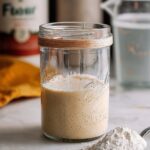If you’ve ever wondered how to keep your sourdough starter bubbly, active, and ready for baking, you’re in for a treat with this easy-to-follow guide on How to Feed Your Sourdough Starter Recipe. Feeding your sourdough starter is the secret behind having a lively, tangy base that can transform simple ingredients into crusty, flavorful bread. This article will walk you through the essentials of nurturing your starter back to life, ensuring it thrives and gives you that delightful rise and aroma every time you bake.
Ingredients You’ll Need

Ingredients You’ll Need
Feeding your sourdough starter is wonderfully simple and relies on just a few fundamental, high-quality ingredients. Each one plays a vital role: from keeping your culture hydrated to providing the perfect nourishment for those wild yeast and bacteria to flourish.
- 100 grams active sourdough starter: This is your living culture, full of natural yeast and bacteria essential for fermentation and flavor development.
- 100 grams filtered water: Using filtered water at room temperature or slightly lukewarm helps maintain the starter’s health and encourages fermentation without introducing harmful chemicals.
- 100 grams all-purpose flour: A versatile flour that provides the carbohydrates and proteins your starter microbes feed on, ensuring consistent rise and delicious tanginess.
How to Make How to Feed Your Sourdough Starter Recipe
Step 1: Measure and Prepare Ingredients
Start by measuring out 100 grams of your active sourdough starter. It’s important that your starter is lively and bubbling for the best results, as this means the yeast and bacteria are ready to feast. Next, measure 100 grams of filtered water, ideally at room temperature or slightly warmed to about 75°F (24°C) so it doesn’t shock your microbes. Lastly, weigh 100 grams of all-purpose flour—this amount offers just enough food to keep your starter healthy and vigorous without overwhelming it.
Step 2: Mix Your Starter Feed
In a clean bowl or jar, combine your starter, water, and flour. Stir gently but thoroughly until the mixture is smooth and lump-free. The consistency should be like a thick batter, which allows the natural yeasts to disperse evenly and thrive. Ensure your container is spacious enough for your starter to expand as it ferments. Cover the jar loosely with a lid or cloth to keep out debris while allowing airflow.
Step 3: Let It Ferment
Leave your fed starter at room temperature for 4 to 8 hours, depending on the ambient temperature and how active your starter is. You’ll notice bubbles forming as the yeast gets to work, and the mixture will grow in volume. This peak of activity means your starter is happily fed and ready to use for baking or can be stored and fed again later.
How to Serve How to Feed Your Sourdough Starter Recipe
Garnishes
While you don’t garnish a sourdough starter, you can think of adding seeds or herbs to your bread dough once your starter is ready. This adds beautiful texture and flavor when baking that signature sourdough loaf.
Side Dishes
After feeding your starter and baking, it pairs brilliantly with fresh butter, olive oil, or your favorite jam. The tangy bread is a wonderful companion to soups, cheeses, or simply a crunchy snack on its own.
Creative Ways to Present
Use your fed starter to create unique bread shapes like boules, baguettes, or even sourdough pancakes and waffles. With a healthy starter, the possibilities are endless, making each presentation a personal expression of your baking passion.
Make Ahead and Storage
Storing Leftovers
If you’ve fed your starter but aren’t ready to bake right away, store it in the refrigerator. The cold slows fermentation down dramatically, letting your starter rest until the next feeding or bake.
Freezing
Freezing your sourdough starter is possible but generally not recommended for frequent use, as repeated freezing can weaken the yeast. If needed, freeze a small portion in an airtight container and thaw it gently before reviving with fresh feedings.
Reheating
You don’t reheat sourdough starter itself, but when using it in recipes, warm your dough gently to encourage fermentation. Keeping your baking environment cozy helps your starter work its magic for tender, airy bread.
FAQs
How often should I feed my sourdough starter?
Typically, feeding your starter once a day at room temperature is ideal. If kept in the fridge, feeding once a week usually suffices to keep it healthy and active.
Can I use different flours to feed my starter?
Absolutely! While all-purpose flour is common and reliable, whole wheat or rye flour can boost fermentation thanks to their additional nutrients. Just note that flour types can affect flavor and activity.
What if my starter looks unusual or smells off?
A healthy starter should smell pleasantly sour, like yogurt or mildly tangy apples. If it develops dark colors, pink hues, or a strong foul odor, it might be contaminated and it’s best to start fresh.
How do I know when my starter is ready to bake with?
Your starter is ready when it doubles in size within 4 to 6 hours after feeding and is bubbly and airy. A simple float test—dropping a spoonful in water—can confirm it’s well-aerated and ready.
Can I skip feeding my starter before baking?
Feeding just before baking provides your starter with fresh food, giving it strength to leaven your bread effectively. Skipping feeding can lead to less rise and a denser crumb.
Final Thoughts
Embracing the rhythm of How to Feed Your Sourdough Starter Recipe is one of the most rewarding parts of baking at home. With just a few simple ingredients and a little love, you create a living ingredient that brings extraordinary depth of flavor and texture to your bread. Remember, your starter is a tiny ecosystem, and feeding it properly sets the stage for countless delicious creations. So go ahead, get feeding, and enjoy this wonderfully tactile connection to the art of sourdough baking!
Print
How to Feed Your Sourdough Starter Recipe
- Prep Time: 5 minutes
- Cook Time: N/A
- Total Time: 5 minutes
- Yield: 300 grams (approximately 1.5 cups) refreshed sourdough starter
- Category: Starter Maintenance
- Method: No-Cook
- Cuisine: Universal
Description
Learn how to properly feed your sourdough starter to keep it active and healthy for baking. This simple process involves mixing an equal weight of starter, water, and flour to produce approximately 300 grams of refreshed starter ready for baking or further feeding.
Ingredients
Ingredients
- 100 grams active sourdough starter (approximately 1/2 cup)
- 100 grams filtered water (approximately 1/2 cup), room temperature to lukewarm
- 100 grams all-purpose flour (approximately 1 scant cup)
Instructions
- Measure your ingredients: Accurately weigh 100 grams of your active sourdough starter and place it into a clean mixing bowl. Then weigh 100 grams of filtered water, preferably at room temperature or slightly lukewarm, to ensure optimal fermentation conditions.
- Add flour and mix: Add 100 grams of all-purpose flour to the starter and water mixture. Stir thoroughly until fully combined into a smooth, thick batter with no dry flour remaining. This balanced ratio helps feed the natural yeast and bacteria in your starter effectively.
Notes
- Use filtered water to avoid chlorine or other chemicals that may inhibit fermentation.
- Maintaining equal weights of starter, water, and flour ensures consistent feeding and predictable fermentation.
- If your kitchen is cold, lukewarm water can help activate the starter faster.
- Stir thoroughly to incorporate air and evenly distribute the flour and water to all microorganisms.








